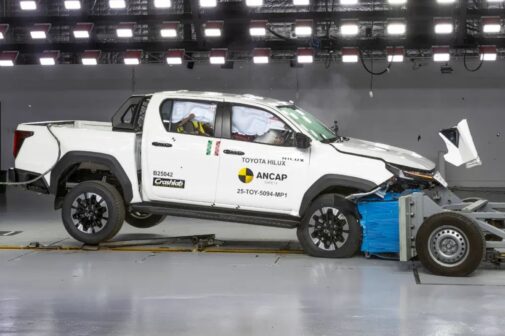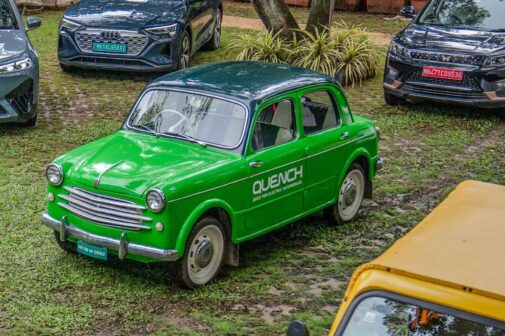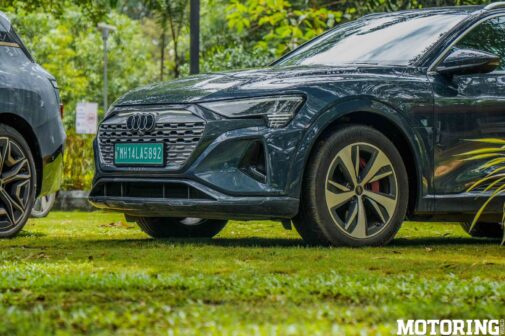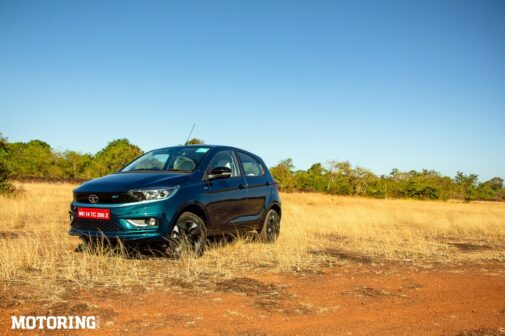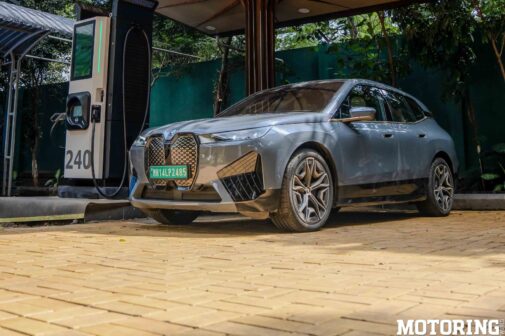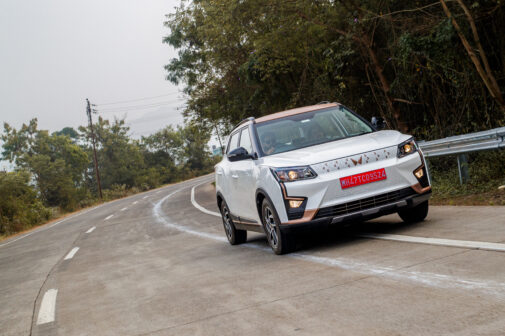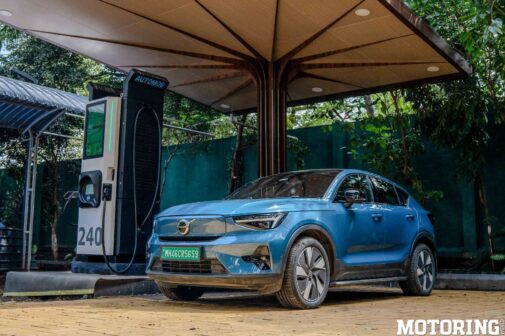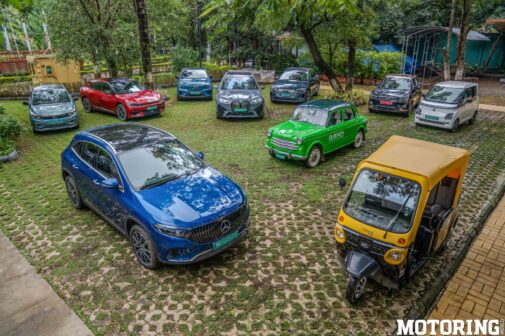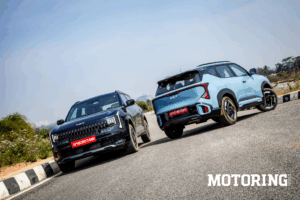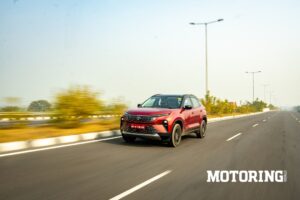Motoring World celebrated World EV Day with a selection of cars that would even make petrolheads jealous. From vintage classics to modern sports cars with performance that dreams can only fulfil, we got them all and brought them together at the same time. Here is our lineup.
1954 Fiat Millecento: A classic that went electric!
In true Motoring World fashion, this classic now goes electric as the world’s first vintage car to do so. There is a certain charm and awe with a vintage car; it reflects a time of simplicity. The world was fresh with cooperation, recovering from a war. Industries needed rebuilding, and the world wanted to start again. Human passion survived through generations, prominently shown in the cars and bikes of that era. The Fiat Millecento is just that and the first!
This car comes with a special thanks to Quench Chargers who, not only gave us this amazing location for our shoot but are also the genius minds behind the Fiat’s electric transplant. Check them out by clicking here.
MG Comet: Meet the cute and funky-coloured member of the EV bunch with its own little cult.
We will be honest; when this car came out, we were bewildered. This 41 bhp and 11 kgm little MG could only reach a comfortable 60 kph. It felt like the car from Mr. Bean, not the iconic green Mini, but the blue Reliant Supervan, which everyone questioned. Coming with a price tag of Rs. 6.99 Lakh (ex-showroom), this car retains the most affordable tag of this lot.
However, the MG Comet has grown on the Indian community, maybe not in the way MG intended, but it has developed its own little cult.
Audi Q8 E-Tron: Audi Should have called this the Iron Man Mark 40.
The Audi Q8 is a pleasure to drive, one you can swing around the corner with a big grin! Make it more exciting, said Audi execs, and they added an electric powertrain, turning it into a bullet train on tarmac. The E-tron is not the compromise for petrol costs; it is not for the environmentally friendly sort. It is meant for the driver who wants all torque and power at a push of the pedal. And this will deliver! With 408 bhp and 67 kgm, this electric marvel would make Tony Stark rethink the name and call it the Mark 40.
For non-Marvel fans, the Mark 40 could do speeds in excess of Mach 5. While this car will not reach Mach 5, it can do 0 to 100 kph in just under 6 seconds. Did I mention this car weighs nearly three tonnes? The price, not to forget, is Rs. 1.15 crore. A fitting price tag? Maybe….
Kia EV6: If style is what you desire, this Korean make could be your answer.
Make no mistake; this car will go, and it will go quite well. Powered by 320 bhp peak power and 61 kgm peak torque, this sleek cyberpunk beauty can do 0 to 100 kph in just 5.2 seconds. You may think this car is more powerful than the Q8 until you realise it weighs close to a tonne less. Perspective! The Kia EV6 is perhaps the most attention-grabbing of the bunch. It looks straight out of Blade Runner. Imagine Deckard hunting replicants before realising his true fate. Goosebumps, the same this car gives when you see it for the first time.
Mercedes EQA: A modern classic hit piece.
The de facto representative of EVs in the luxury segment, having established its roots firmly in the Indian market, the Mercedes comes in strong. Their ever-growing EV platform represents that strength. The EQA, what we call the ‘Electric EQAtion,’ made Mercedes a contender in the EV market. With 188 bhp maximum power and 39 kgm maximum torque, this electric motor can do 0 to 100 kph in 8.6 seconds and has a range of nearly 300 km when we reviewed it.
It isn’t the quickest on the road, but it covers Goa with a certain comfort that makes you shy away from any ICE variants. It does carry a price tag of Rs. 66 Lakh; despite its quirks, this EV remains the most affordable out of the German three on our list. Quite the bang for your buck!
2024 TATA Tiago EV: The average Joe.
The average Joe is the most populated point in every answer. The Indian EV market is but a fraction of its ICE counterpart, but in that fraction, nearly 80 per cent involves Tata Motors. Not a first for the company, and certainly not their last. Priced at Rs. 8.49 lakh, this car remains the second most affordable on this list. It is similar in every way except the powertrain compared to its ICE variant. Powered by a 74 bhp and 11.62 kgm electric motor, this car will not perform seriously on the drag strip. Yet, the average Joe will select this because it makes sense at its price point.
It can charge itself in under four hours to 100 per cent, claims a top speed of 116 kph, which is sufficient for any city. The car runs well at lower speeds and is friendly to first-time EV users.
BMW iX: Revolution against a traditional setup.
Rounded out of the big German three is BMW. This car has not received the attention that its competitors, Audi and Mercedes, have, while it is still a lovely machine. It falls short on some accounts, where its competitors win. But a charm is retained. The electric motor produces 322 bhp of power and 64.24 kgm of torque, allowing it to accelerate to 100 kph in just over 4 seconds. It is the quickest of the German three on our list.
The EV is easy to drive; we call it effortless. A car that encourages a leisurely coffee while charging, it just works within your ecosystem as any BMW would. This EV is otherwise the same as any other BMW; that’s where it falls short. The same interior, the same 14-inch infotainment system, and the same instrument cluster (albeit with unique sounds). That is not to say it is a bad thing; it is rather tasteful.
But with a price tag of Rs. 1.16 crore, it encourages foresight into others on the market because at this price point, the comforts of life are seldom left out.
Mahindra XUV 400 EV: Follows the XUV success with an electric touch.
Rivaling the Tata Nexon EV comes the Mahindra XUV 400 EV, with body components from the XUV 300. Mahindra is a unique reminder of how the mid-segment market works. Make one body and drop every brand and logo. The 400 EV is nearly identical to the XUV 300, except for the new blacked-out grille, new badge, distinctive additions, dual-tone roof and body, etc. From the inside, the EV feels familiar. That is its strength.
The electric motor outputs a maximum power of 147 bhp and max torque of 31 kgm, making for an interesting drive. The car tops out at 160 kph, although reaching there is nearly impossible without a clear stretch of road. How did we do it? At Mahindra’s testing facility, normal road conditions see the car reach 150 kph at most. Regarding range, we got about 400 km before it needs a dash of electric juice, which took about 50 mins via fast charging. At Rs. 15.99 lakh, this is definitely the EV that cuts it right in the middle.
Volvo C40 Recharge: Safety requires an electric charge
At Motoring World, we love this car, and for good reason—it makes sense, no matter how you look at it. When discussing the Tata, the appeal lies in its price tag. In contrast, with the E-Tron, it’s all about performance. However, the Volvo makes sense on every level. But why?
Volvo means safety and trust, values the brand has stood by since its inception. Furthermore, the electric powertrain is modest for its price of Rs. 60 lakh, offering a maximum power of 407 bhp and 67.30 kgm of torque, along with a range of nearly 500 km. In terms of charging time, it only takes 27 minutes to reach 80 per cent—quick indeed.
Moreover, the Volvo is the ‘family choice’. It handles our roads well, boasts a stylish interior, and features level 3 ADAS, which is often overlooked by cars priced at even Rs. 1 crore! Overall, it’s confidence-inspiring and, as we’ve called it, a ‘mother’s sustainable choice’. That’s the best one-liner to describe this car.
Mahindra Treo: And there is always that one!
The electric auto-rickshaw by Mahindra makes a surprise and impressive entry into our list. Carrying a price tag of Rs. 3.44 lakh, this EV auto can top out at 55 kph and can drive a range of 150 km on a single charge. Powered by a single electric motor, it produces 10.54 bhp and 4.29 kgm of torque.
In retrospect, the Bajaj RE Auto, the most common model you will find, is powered by a petrol single-cylinder engine that does 10.73 bhp and 1.96 kgm. That is one for the Treo.
Other notable features like the passenger doors, USB charging ports and a charging time of about 4 hours make an impressive case. States like Karnataka have already begun empowering female auto drivers with electric rickshaws. While not the same model, the slow but faithful adoption is strong with no stopping.
And that was our lineup for World EV Day. For the average petrol fan, this is rather concerning. Yes, I am concerned, but not for the loss of petrol but the entire garage that will now change in the blink of an eye. It is a very quiet revolution, and it sees no end.









